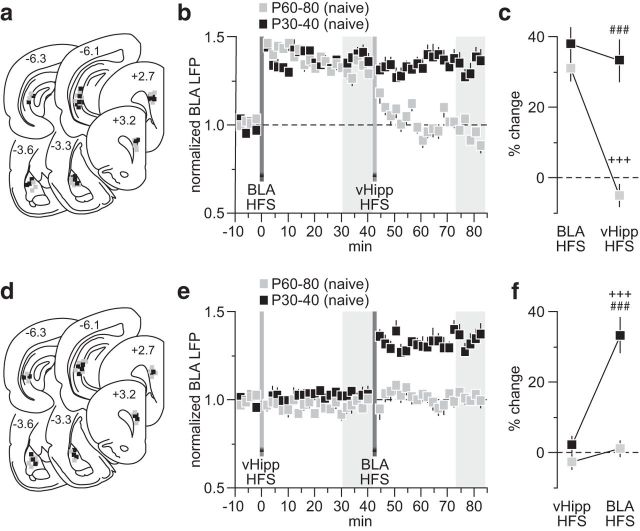Figure 6.
Developmental regulation of vHipp-dependent inhibitory control of BLA transmission in the PFC. a, Summary of the recording sites (PFC) and stimulating sites (BLA and vHipp). b, Age-dependent effect of vHipp HFS on BLA-LTP in the PFC. A clear depotentiation of the BLA-LTP by the vHipp drive was observed only in the P60–80 age group (n = 7), whereas HFS of the vHipp failed to alter the BLA-evoked LTP in the P30–40 PFC (n = 7). c, Summary of the PFC response obtained at 30–40 min post-HFS. Two-way ANOVA revealed a main effect of input stimulation (F(1,24) = 19.7, p < 0.0005), a main effect of age (F(1,24) = 28.4, p < 0.0005), and an age × input stimulation interaction (F(1,24) = 14.1, p < 0.005; ###p < 0.0005 vs P60–80, +++p < 0.0005 vs BLA HFS, LSD post hoc test). d, Summary of the recording and stimulating sites from another cohort of naive rats in which the vHipp HFS was delivered prior to BLA induction of PFC LTP. e, PFC recordings from the P60–80 (n = 7) age group revealed an inhibitory effect of vHipp HFS on the expression of BLA-LTP. Such inhibitory control by the vHipp is lacking in the PFC of P30–40 rats (n = 6). f, Summary of the PFC response obtained 30–40 min post-HFS period. Two-way ANOVA revealed a main effect of input stimulation (F(1.22) = 32.6, p < 0.0005), a main effect of age (F(1,22) = 37, p < 0.0005), and an age × input stimulation interaction (F(1,22) = 20.1, p < 0.0005; ###p < 0.0005 vs P60–80, +++p < 0.0005 vs vHipp HFS, LSD post hoc test).

